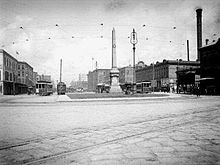
Moon Edwin Landrieu was an American lawyer and politician who served as the 56th mayor of New Orleans from 1970 to 1978. A member of the Democratic Party, he represented New Orleans' Twelfth Ward in the Louisiana House of Representatives from 1960 to 1966, served on the New Orleans City Council as a member at-large from 1966 to 1970, and was the United States Secretary of Housing and Urban Development under U.S. president Jimmy Carter from 1979 to 1981.
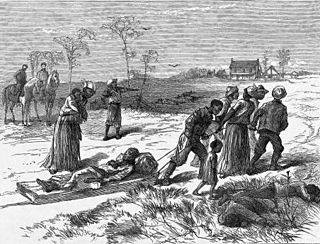
The Colfax massacre, sometimes referred to as the Colfax riot, occurred on Easter Sunday, April 13, 1873, in Colfax, Louisiana, the parish seat of Grant Parish. An estimated 62–153 Black militia men were murdered while surrendering to a mob of former Confederate soldiers and members of the Ku Klux Klan. Three white men also died during the confrontation.
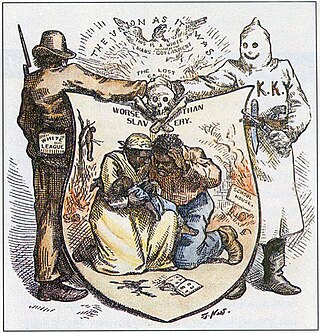
The White League, also known as the White Man's League, was a white supremacist paramilitary terrorist organization started in the Southern United States in 1874 to intimidate freedmen into not voting and prevent Republican Party political organizing, while also being supported by regional elements of the Democratic Party. Its first chapter was formed in Grant Parish, Louisiana, and neighboring parishes and was made up of many of the Confederate veterans who had participated in the Colfax massacre in April 1873. Chapters were soon founded in New Orleans and other areas of the state.

The Sons of Confederate Veterans (SCV) is an American neo-Confederate nonprofit organization of male descendants of Confederate soldiers that commemorates these ancestors, funds and dedicates monuments to them, and promotes the pseudohistorical Lost Cause ideology and corresponding white supremacy.
The Coushatta massacre (1874) was an attack by members of the White League, a white supremacist paramilitary organization composed of white Southern Democrats, on Republican officeholders and freedmen in Coushatta, the parish seat of Red River Parish, Louisiana. They assassinated six white Republicans and five to 20 freedmen who were witnesses.

Mitchell Joseph Landrieu is an American lawyer and politician who served as Mayor of New Orleans from 2010 to 2018. A member of the Democratic Party, he previously served as Lieutenant Governor of Louisiana from 2004 to 2010.

Victor Hugo "Vic" Schiro, was an American politician who served on the New Orleans City Council and as Mayor from 1961 to 1970.
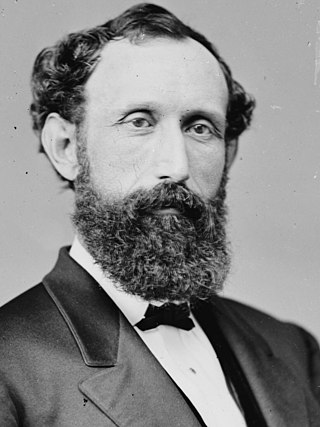
William Pitt Kellogg was an American lawyer and Republican Party politician who served as the governor of Louisiana from 1873 to 1877 and twice served as a United States senator during the Reconstruction era.

John McEnery was a Louisiana Democratic politician and lawyer who was considered by Democrats to be the winner of the highly contested 1872 election for Governor of Louisiana. After extended controversy over election results, the Republican candidate William Pitt Kellogg was certified. McEnery, who had been an officer in the Confederate States Army during the American Civil War, was not allowed to take office following a weighing in by the federal government and local Republicans loyal to President Ulysses S. Grant.

The Wheeler Compromise, sometimes known as the Wheeler Adjustment, was the settlement of the disputed gubernatorial election of 1872 in the U.S. state of Louisiana, and negotiation to organize the state's legislature in January 1875. It was negotiated by, and named after, William A. Wheeler, Congressman from New York and a member of the U.S. House Committee on Southern Affairs. He later was elected as Vice President of the United States.

William Harold Nungesser is an American politician serving as the 54th lieutenant governor of Louisiana since 2016. A member of the Republican Party, Nungesser is also the former president of the Plaquemines Parish Commission, having been re-elected to a second four-year term in the 2010 general election in which he topped two opponents with more than 71 percent of the vote. His second term as parish president began on January 1, 2011, and ended four years later.

The Robert E. Lee Monument, formerly in New Orleans, Louisiana, is a historic statue dedicated to Confederate General Robert E. Lee by American sculptor Alexander Doyle. It was removed (intact) by official order and moved to an unknown location on May 19, 2017. Any future display is uncertain.
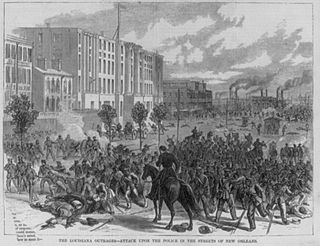
The Battle of Liberty Place, or Battle of Canal Street, was an attempted insurrection and coup d'etat by the Crescent City White League against the Reconstruction Era Louisiana Republican state government on September 14, 1874, in New Orleans, which was the capital of Louisiana at the time. Five thousand members of the White League, a paramilitary terrorist organization made up largely of Confederate veterans, fought against the outnumbered New Orleans Metropolitan Police and state militia. The insurgents held the statehouse, armory, and downtown for three days, retreating before arrival of federal troops that restored the elected government. At least 32 people, including at least 21 Neo-Confederate insurgents, were killed in the fighting. No insurgents were charged in the action.

Tivoli Circle is a central traffic circle in New Orleans, Louisiana, which featured a monument to Confederate General Robert E. Lee between 1884 and 2017. During this time the circle was known as Lee Circle until its name reverted to Tivoli Circle in 2022. The inner grass circle around the monument was renamed Harmony Circle at that time.

The General Beauregard Equestrian Statue, honoring P. G. T. Beauregard, was located in New Orleans, Louisiana, United States. The statue, by Alexander Doyle, one of the premier American sculptors, was officially unveiled in 1915.

The Robert E. Lee Monument was an outdoor bronze equestrian statue of Confederate general Robert E. Lee and his horse Traveller located in Charlottesville, Virginia's Market Street Park in the Charlottesville and Albemarle County Courthouse Historic District. The statue was commissioned in 1917 and dedicated in 1924, and in 1997 was listed on the National Register of Historic Places. It was removed on July 10, 2021, and melted down in 2023.

The Jefferson Davis Monument, also known as the Jefferson Davis Memorial, was an outdoor sculpture and memorial to Jefferson Davis, installed at Jeff Davis Parkway and Canal Street in New Orleans, Louisiana, United States from 1911 to 2017.

The Stonewall Jackson and Robert E. Lee Monument, often referred to simply as the Jackson and Lee Monument or Lee and Jackson Monument, was a double equestrian statue of Confederate generals Stonewall Jackson and Robert E. Lee, formerly located on the west side of the Wyman Park Dell in Charles Village in Baltimore, Maryland, alongside a forested hill, similar to the topography of Chancellorsville, Virginia, where Stonewall Jackson and Robert E. Lee met before the Battle of Chancellorsville in 1863. The statue was removed on August 16, 2017, on the order of Baltimore City Council, but the base still remains. The monument is in storage and some city council members have called for all Confederate monuments in the state to be destroyed.

More than 160 monuments and memorials to the Confederate States of America and associated figures have been removed from public spaces in the United States, all but five since 2015. Some have been removed by state and local governments; others have been torn down by protestors.
Norman C. Francis Parkway, formerly named Jefferson Davis Parkway or Jeff Davis Parkway, is a street in New Orleans, Louisiana, United States. It runs southwest from the head of Bayou St. John in the Mid-City neighborhood to Martin Luther King, Jr. Boulevard in the Gert Town neighborhood. Like most streets in New Orleans, the segment of the parkway to the north east of Canal Street is named "North" Norman C. Francis Parkway while the segment to the southwest is denoted as "South". The parkway is wide with a grassy median except for where it crosses over the Pontchartrain Expressway.


